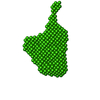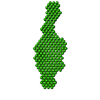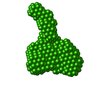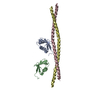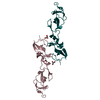[English] 日本語
 Yorodumi
Yorodumi- SASDF57: Complex of CBP KIX domain with BMAL1 (G517-L625) including C-term... -
+ Open data
Open data
- Basic information
Basic information
| Entry | Database: SASBDB / ID: SASDF57 |
|---|---|
 Sample Sample | Complex of CBP KIX domain with BMAL1 (G517-L625) including C-terminal transactivation domain (TAD) (Mus musculus)
|
| Function / homology |  Function and homology information Function and homology informationActivation of the TFAP2 (AP-2) family of transcription factors / Regulation of FOXO transcriptional activity by acetylation / TRAF6 mediated IRF7 activation / Nuclear events mediated by NFE2L2 / Attenuation phase / LRR FLII-interacting protein 1 (LRRFIP1) activates type I IFN production / RUNX1 regulates transcription of genes involved in differentiation of myeloid cells / Formation of the beta-catenin:TCF transactivating complex / NOTCH1 Intracellular Domain Regulates Transcription / RUNX3 regulates NOTCH signaling ...Activation of the TFAP2 (AP-2) family of transcription factors / Regulation of FOXO transcriptional activity by acetylation / TRAF6 mediated IRF7 activation / Nuclear events mediated by NFE2L2 / Attenuation phase / LRR FLII-interacting protein 1 (LRRFIP1) activates type I IFN production / RUNX1 regulates transcription of genes involved in differentiation of myeloid cells / Formation of the beta-catenin:TCF transactivating complex / NOTCH1 Intracellular Domain Regulates Transcription / RUNX3 regulates NOTCH signaling / Regulation of gene expression by Hypoxia-inducible Factor / cAMP response element binding protein binding / Notch-HLH transcription pathway / Transcriptional and post-translational regulation of MITF-M expression and activity / germ-line stem cell population maintenance / negative regulation of viral process / Regulation of lipid metabolism by PPARalpha / Cytoprotection by HMOX1 / Estrogen-dependent gene expression / CD209 (DC-SIGN) signaling / peptide lactyltransferase (CoA-dependent) activity / outer kinetochore / negative regulation of interferon-beta production / histone H3K18 acetyltransferase activity / N-terminal peptidyl-lysine acetylation / histone H3K27 acetyltransferase activity / MRF binding / face morphogenesis / negative regulation of transcription by RNA polymerase I / protein-lysine-acetyltransferase activity / cellular response to hepatocyte growth factor stimulus / acetyltransferase activity / TFIIB-class transcription factor binding / histone acetyltransferase complex / positive regulation of DNA-binding transcription factor activity / histone acetyltransferase activity / positive regulation of double-strand break repair via homologous recombination / histone acetyltransferase / Transferases; Acyltransferases; Transferring groups other than aminoacyl groups / RNA polymerase II transcription regulatory region sequence-specific DNA binding / PML body / protein destabilization / cellular response to virus / RNA polymerase II transcription regulator complex / disordered domain specific binding / cellular response to UV / rhythmic process / transcription regulator complex / molecular adaptor activity / DNA-binding transcription factor binding / damaged DNA binding / RNA polymerase II-specific DNA-binding transcription factor binding / transcription coactivator activity / protein domain specific binding / chromatin binding / positive regulation of gene expression / regulation of DNA-templated transcription / chromatin / positive regulation of DNA-templated transcription / positive regulation of transcription by RNA polymerase II / protein-containing complex / DNA binding / zinc ion binding / nucleoplasm / nucleus / cytoplasm Similarity search - Function |
| Biological species |  |
 Citation Citation |  Journal: J Biol Chem / Year: 2019 Journal: J Biol Chem / Year: 2019Title: Structural and mechanistic insights into the interaction of the circadian transcription factor BMAL1 with the KIX domain of the CREB-binding protein. Authors: Archit Garg / Roberto Orru / Weixiang Ye / Ute Distler / Jeremy E Chojnacki / Maja Köhn / Stefan Tenzer / Carsten Sönnichsen / Eva Wolf /  Abstract: The mammalian CLOCK:BMAL1 transcription factor complex and its coactivators CREB-binding protein (CBP)/p300 and mixed-lineage leukemia 1 (MLL1) critically regulate circadian transcription and ...The mammalian CLOCK:BMAL1 transcription factor complex and its coactivators CREB-binding protein (CBP)/p300 and mixed-lineage leukemia 1 (MLL1) critically regulate circadian transcription and chromatin modification. Circadian oscillations are regulated by interactions of BMAL1's C-terminal transactivation domain (TAD) with the KIX domain of CBP/p300 (activating) and with the clock protein CRY1 (repressing) as well as by the BMAL1 G-region preceding the TAD. Circadian acetylation of Lys within the G-region enhances repressive BMAL1-TAD-CRY1 interactions. Here, we characterized the interaction of the CBP-KIX domain with BMAL1 proteins, including the BMAL1-TAD, parts of the G-region, and Lys Tethering the small compound 1-10 in the MLL-binding pocket of the CBP-KIX domain weakened BMAL1 binding, and MLL1-bound KIX did not form a ternary complex with BMAL1, indicating that the MLL-binding pocket is important for KIX-BMAL1 interactions. Small-angle X-ray scattering (SAXS) models of BMAL1 and BMAL1:KIX complexes revealed that the N-terminal BMAL1 G-region including Lys forms elongated extensions emerging from the bulkier BMAL1-TAD:KIX core complex. Fitting high-resolution KIX domain structures into the SAXS-derived envelopes suggested that the G-region emerges near the MLL-binding pocket, further supporting a role of this pocket in BMAL1 binding. Additionally, mutations in the second CREB-pKID/c-Myb-binding pocket of the KIX domain moderately impacted BMAL1 binding. The BMAL1(K537Q) mutation mimicking Lys acetylation, however, did not affect the KIX-binding affinity, in contrast to its enhancing effect on CRY1 binding. Our results significantly advance the mechanistic understanding of the protein interaction networks controlling CLOCK:BMAL1- and CBP-dependent gene regulation in the mammalian circadian clock. |
 Contact author Contact author |
|
- Structure visualization
Structure visualization
| Structure viewer | Molecule:  Molmil Molmil Jmol/JSmol Jmol/JSmol |
|---|
- Downloads & links
Downloads & links
-Data source
| SASBDB page |  SASDF57 SASDF57 |
|---|
-Related structure data
| Related structure data | C: citing same article ( |
|---|---|
| Similar structure data |
- External links
External links
| Related items in Molecule of the Month |
|---|
-Models
| Model #3052 |  Type: dummy / Software: (5.3) / Radius of dummy atoms: 2.50 A / Chi-square value: 1.235 / P-value: 0.355801  Search similar-shape structures of this assembly by Omokage search (details) Search similar-shape structures of this assembly by Omokage search (details) |
|---|
- Sample
Sample
 Sample Sample | Name: Complex of CBP KIX domain with BMAL1 (G517-L625) including C-terminal transactivation domain (TAD) (Mus musculus) Specimen concentration: 4.37 mg/ml / Entity id: 1678 / 1679 |
|---|---|
| Buffer | Name: 25 mM Hepes, 150 NaCl, 1 mM DTT, 5% Glycerol / pH: 7.2 |
| Entity #1678 | Name: BMAL1-(517-625) / Type: protein Description: Brain and muscle ARNT-like 1 (G517-L625) including transactivation domain (TAD) Formula weight: 11.128 / Num. of mol.: 1 / Source: Mus musculus / References: UniProt: Q9WTL8-2 Sequence: GPGSSPLNIT STPPPDASSP GGKKILNGGT PDIPSTGLLP GQAQETPGYP YSDSSSILGE NPHIGIDMID NDQGSSSPSN DEAAMAVIMS LLEADAGLGG PVDFSDLPWP L |
| Entity #1679 | Name: CBP KIX domain / Type: protein Description: Kinase-inducible domain interacting (KIX) domain of CREB-binding protein (CBP) Formula weight: 10.486 / Num. of mol.: 1 / Source: Mus musculus / References: UniProt: P45481 Sequence: GPGVRKGWHE HVTQDLRSHL VHKLVQAIFP TPDPAALKDR RMENLVAYAK KVEGDMYESA NSRDEYYHLL AEKIYKIQKE LEEKRRSRL |
-Experimental information
| Beam | Instrument name: PETRA III EMBL P12 / City: Hamburg / 国: Germany  / Type of source: X-ray synchrotron / Wavelength: 0.124 Å / Dist. spec. to detc.: 3 mm / Type of source: X-ray synchrotron / Wavelength: 0.124 Å / Dist. spec. to detc.: 3 mm | |||||||||||||||||||||
|---|---|---|---|---|---|---|---|---|---|---|---|---|---|---|---|---|---|---|---|---|---|---|
| Detector | Name: Pilatus 2M | |||||||||||||||||||||
| Scan | Measurement date: May 27, 2017 / Storage temperature: 10.2 °C / Cell temperature: 10.2 °C / Exposure time: 0.045 sec. / Number of frames: 30 / Unit: 1/nm /
| |||||||||||||||||||||
| Distance distribution function P(R) |
| |||||||||||||||||||||
| Result |
|
 Movie
Movie Controller
Controller


